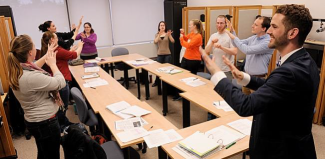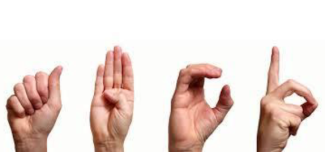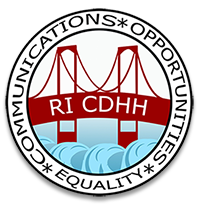American Sign Language
- What is American Sign Language?
- Five (5) common misconceptions people have about ASL
- Where can I take sign language (ASL) classes in Rhode Island?
- Where can I find additional information about ASL?
- For Parents: Where can I find information and resources for my deaf child?

What Is American Sign Language (ASL)?
ASL, short for American Sign Language, is the sign language most commonly used by the Deaf and Hard of Hearing people in the United States.
Approximately more than a half-million people throughout the US (1) use ASL to communicate as their native language. ASL is the third most commonly used language in the United States, after English and Spanish.
Contrary to popular belief, ASL is not representative of English nor is it some sort of imitation of spoken English that we use on a day-to-day basis. For many, it will come as a great surprise that ASL has more similarities to spoken Japanese and Navajo than to English.
When we discuss ASL or any other type of sign language, we are referring to what is called a visual language. The visual component refers to the use of body movements versus sound.
Because “listeners” must use their eyes to “receive” the information, this language was specifically created to be easily recognized by the eyes. The visual component refers to the body movements or signs that are performed to convey a message.
A Brief History of ASL
ASL is a relatively new language, which first appeared in the 1800s’ with the founding of the first successful American School for the Deaf by Thomas Hopkins Gallaudet and Laurent Clerc (first Deaf Teacher from France) in 1817.
With strong roots in French Sign Language, ASL evolved to incorporate the signs students would use in less formal settings such as in their home or within the deaf community.
As students graduated from the American School for the Deaf, some went on to open their own schools, passing along this evolving American Sign Language as the contact language for the deaf in the United States.
Is There a Universal Sign Language?
There is no universal language for the deaf – all over the world, different sign languages have developed that vary from one another. According to the World Federation of the Deaf, there are over 300 signed languages in the world.
A spoken English speaker from the USA, for example, can generally understand someone from another English-speaking nation such as England or Australia.
But with sign language, someone who signs using American Sign language would not be able to understand someone who signs using British Sign Language (BSL) or even Australian (Auslan).
(1) Mitchell, Ross E., et al. (2006). How Many People Use ASL in the United States? Gallaudet University, Gallaudet Research Institute, Washington, D.C.
Five (5) Common Misconceptions About ASL
Like any foreign language, ASL falls victim to many misconceptions among those who have not explored the language.
Because of the word ‘American' in its name, many assume it shares the same qualities as English and is simply a representation of English using hands and gestures.
However, this is not the case. Let's look at five (5) of the most common misconceptions about ASL:
As you've probably realized by now, ASL has little in common with spoken English, nor is it some sort of signed representation of English words.
ASL was formed independently of English and has its own unique sentence structure and symbols for various words and ideas.
- The key features of ASL are:
- hand shape
- palm orientation
- hand movement
- hand location
- gestural features like facial expression and posture
When English is used through fingerspelling, hand motions represent the English alphabet to spell words in English, but this is not actually a part of ASL. Rather, it's a separate element of signed communication.

Another common misconception about ASL is that it is some form of shorthand, or rapid communication by means of abbreviations and symbols.
This misconception arises since ASL does not have a written component.
To call ASL shorthand is sorely incorrect, as ASL is a complex language system with its own set of linguistic components.

Although the United States and the United Kingdom share spoken English as their predominant language, American Sign Language and British Sign Language vary greatly.
In fact, American Sign Language has its roots in French Sign Language, while British Sign Language has had a greater influence on the development of Australian Auslan and New Zealand Sign Language.
In ASL, fingerspelling is reserved for borrowing words from the English language for proper nouns and technical terms with no ASL equivalent.
For example, fingerspelling can be used for people's names, places, titles, and brands.
When fingerspelling is used in ASL, it's done using the American Fingerspelled Alphabet. This alphabet has 22 handshapes, that, when held in certain positions or movements represent the 26 letters of the English alphabet.
Need Content
It's estimated that only 30% of English can be read on the lips by the deaf.
Lip reading is also not an effective because it's a one-way method of communication. It's very unlikely that the speaker will be nearly as skilled at lip reading as those who are fluent in ASL, as learning to lip read well can take years upon years of practice.
This means that lip reading is not an effective method for two-way communication.
Where can I learn Sign Language - ASL?
Like any other language, getting the hang of ASL simply requires lots of practice and determination. You just need to get started.
See where you can take sign language classes in Rhode Island
Where can I find additional information about ASL?
For Parents: Where can I find additional information and resources for my deaf child?
